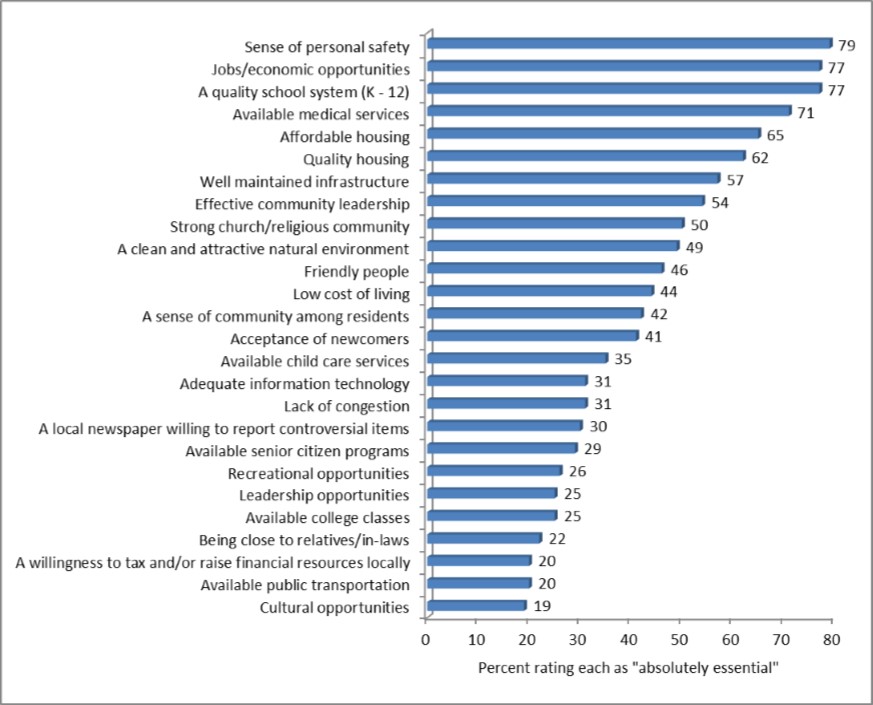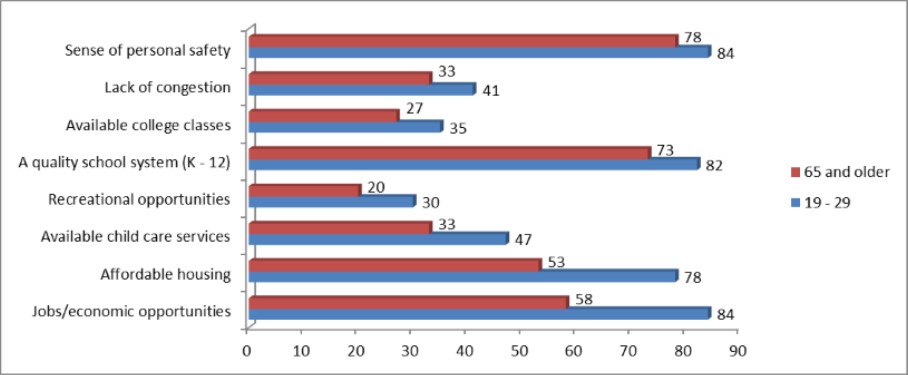What People See as Absolutely Essential Rural Community Characteristics: Younger vs. Older Adults
When a 19-year-old looks at a rural community what characteristics are essential to this person? What are they looking for? Now think about someone who is 65 or older - what is essential to this person? You might presume that these two groups, younger and older adults, would have very little in common. Granted, there are differences in what these age groups see as essential, but there are also characteristics that both age groups rate similarly.
The 2014 Nebraska Rural Poll report1, scheduled to be published in late October, asked the following question, "How essential or necessary are the following characteristics of a community in order for you to have a high quality of life?" The answer responses included: not at all essential; nice, but not essential; important, but not essential; and absolutely essential.
The 1,943 responses of rural Nebraskans, regardless of age, indicated that the "absolutely essential" community characteristics included the following (see Figure 1).

Overall, there should be few surprises at what characteristics bubble up to the top as well as those that flow toward the bottom of the list. Safety, jobs, quality schools, medical services, and the quality and quantity of housing all rate very high. In contrast, being close to relatives/in-laws, a willingness to tax and/or raise financial resources locally, available transportation and cultural opportunities were all rated at the bottom of the list or were not considered "absolutely essential" as compared to other community characteristics by those surveyed.
The interesting part comes when you compare the responses by age and contrast the 65 and older group with the 19 to 29-year-olds. The older adults see some of these characteristics as being a little more essential, like being close to relatives/in-laws, available public transportation, having a well maintained infrastructure, and even the acceptance of new comers, than the younger 19-29-year-olds. But as you look down the list, there is a significant difference between the two groups within such characteristics as a sense of community among residents, effective community leadership, available senior citizen programs, strong church/religious community and a local newspaper willing to report controversial items (see Figure 2).

Commonality also exists between the age groups. Both groups feel that quality housing is pretty high on the list of "absolutely essential" community characteristics, both see low cost of living as a mid-range characteristic and adequate information technology, a willingness to tax and/or raise financial resources locally and cultural opportunities toward the bottom (see Figure 3).

Finally, there are issues that young adults rate higher on the "absolutely essential" characteristics list (see Figure 4). A sense of personal safety and lack of congestion are characteristics that the younger age group does see as slightly more essential than those age 65 or older. Other characteristics like available college classes, quality school system, recreational opportunities, child care, affordable housing and jobs/economic opportunity are rated a bit higher by the younger adults than the older adults. Many of these mirror the presumed wants and needs of individuals beginning a career and family life.

Some people might ask’¦ so what? Differences between age groups are interesting but how does that impact the community?
So here is one possibility - first, we assume that a sustainable rural community needs a mix of age groups to keep the community viable into the future.
Traditionally, rural community leadership is often comprised of people who have lived in the community for many years. These years of experience translate into village boards and city councils that are often made up of members 60-65+ years of age.
If community leadership is dominated by just one age group, for instance older adults, it may be harder for the community leadership to see the importance of the essential community characteristics that a younger adult may value.
If they don't see these characteristics as being as important or valued, investments may not be made in these characteristics. This lack of investment may increase the characteristic's deterioration ultimately making the community a less attractive place in which to reside in the eyes of the younger age group
When it comes to understanding what people see as essential rural community characteristics, it is interesting to compare the insights of younger and older adults and to think about how this information can be used in tangible ways.
For instance, if younger adults don't see the community newspaper as an essential communication tool, how could community issues be communicated to reach the younger adults? Is it through a blog, Facebook, or Twitter? Options are out there.
The responses to this question gave a taste of how the two groups see the issue but there is much more to be learned. Knowing how age groups see essential community characteristics differently, as well as the same, can help to position our communities for the future.
1The Nebraska Rural Poll is the nineteenth annual effort to understand rural Nebraskans' perceptions. The 2014 poll consisted of a self-administered questionnaire that was mailed in April to 6,813 randomly selected households. The results of the survey are based on 1,943 responses (29% response rate) from Nebraskans living in 86 counties in the state. For more information about the Poll go to http://ruralpoll.unl.edu
Cheryl Burkhart-Kriesel
Entrepreneurship Business Development
Panhandle Research and Extension Center
308-632-1234
cburkhartkriesel1@unl.edu
Randy Cantrell
Community Development Specialist
UNL Dept. of Ag Economics
Rural Futures Institute
402-472-0919
rcantrell1@unl.edu
Brad Lubben
Extension Policy Specialist
UNL Dept. of Ag Economics
402-472-2235
blubben2@unl.edu
Becky Vogt
Department of Agricultural Economics
University of Nebraska-Lincoln
(402) 329-6251
rvogt2@unl.edu